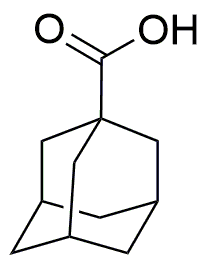1-Adamantanecarboxylic acid is widely utilized in research focused on:
- Pharmaceutical Development: This compound serves as a building block in the synthesis of various pharmaceuticals, particularly antiviral agents, enhancing drug efficacy.
- Polymer Chemistry: It is used to modify polymers, improving their thermal stability and mechanical properties, which is beneficial in creating durable materials for various applications.
- Organic Synthesis: Researchers employ it in organic reactions to produce complex molecules, streamlining the process of creating new compounds with desired properties.
- Material Science: The compound is explored for its potential in developing advanced materials, such as coatings and adhesives, due to its unique structural characteristics.
- Biochemical Research: It is utilized in studies related to enzyme inhibition and receptor binding, offering insights into biological processes and potential therapeutic targets.
Información general
Propiedades
Seguridad y normativas
Aplicaciones
1-Adamantanecarboxylic acid is widely utilized in research focused on:
- Pharmaceutical Development: This compound serves as a building block in the synthesis of various pharmaceuticals, particularly antiviral agents, enhancing drug efficacy.
- Polymer Chemistry: It is used to modify polymers, improving their thermal stability and mechanical properties, which is beneficial in creating durable materials for various applications.
- Organic Synthesis: Researchers employ it in organic reactions to produce complex molecules, streamlining the process of creating new compounds with desired properties.
- Material Science: The compound is explored for its potential in developing advanced materials, such as coatings and adhesives, due to its unique structural characteristics.
- Biochemical Research: It is utilized in studies related to enzyme inhibition and receptor binding, offering insights into biological processes and potential therapeutic targets.
Documentos
Hojas de datos de seguridad (HDS)
La SDS proporciona información de seguridad completa sobre la manipulación, el almacenamiento y la eliminación del producto.
Especificación del producto (PS)
La PS proporciona un desglose completo de las propiedades del producto, incluida la composición química, el estado físico, la pureza y los requisitos de almacenamiento. También detalla los rangos de calidad aceptables y las aplicaciones previstas del producto.
Certificados de análisis (COA)
Busque certificados de análisis (COA) ingresando el número de lote del producto. Los números de lote y de partida se pueden encontrar en la etiqueta de un producto después de las palabras "Lote" o "Lote".
Número de catálogo
Número de lote/lote
Certificados de origen (COO)
Este certificado de origen confirma el país en el que se fabricó el producto y también detalla los materiales y componentes utilizados en él y si se deriva de fuentes naturales, sintéticas u otras fuentes específicas. Este certificado puede ser necesario para cumplir con las normativas aduaneras, comerciales y regulatorias.
Número de catálogo
Número de lote/lote
Hojas de datos de seguridad (HDS)
La SDS proporciona información de seguridad completa sobre la manipulación, el almacenamiento y la eliminación del producto.
DownloadEspecificación del producto (PS)
La PS proporciona un desglose completo de las propiedades del producto, incluida la composición química, el estado físico, la pureza y los requisitos de almacenamiento. También detalla los rangos de calidad aceptables y las aplicaciones previstas del producto.
DownloadCertificados de análisis (COA)
Busque certificados de análisis (COA) ingresando el número de lote del producto. Los números de lote y de partida se pueden encontrar en la etiqueta de un producto después de las palabras "Lote" o "Lote".
Número de catálogo
Número de lote/lote
Certificados de origen (COO)
Este certificado de origen confirma el país en el que se fabricó el producto y también detalla los materiales y componentes utilizados en él y si se deriva de fuentes naturales, sintéticas u otras fuentes específicas. Este certificado puede ser necesario para cumplir con las normativas aduaneras, comerciales y regulatorias.


